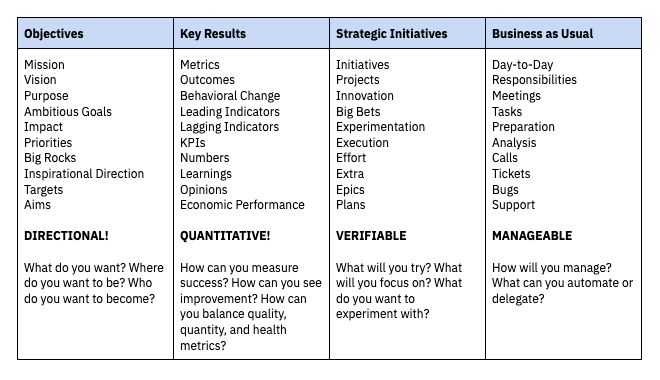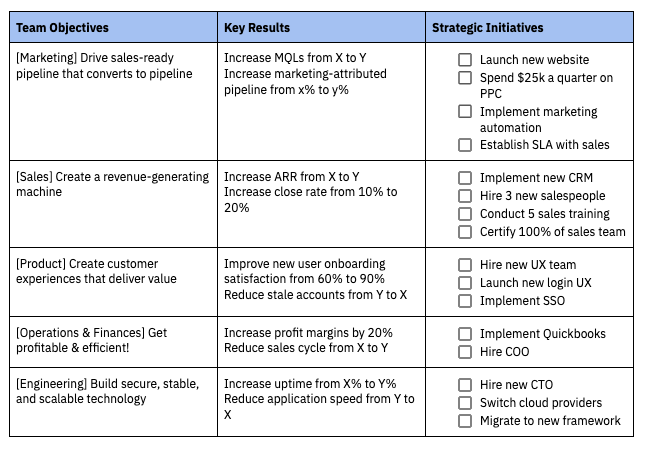8 min read
Rethink OKRs: Improve Cultural Engagement with Your Own System
Here we'll explore the backstory of OKRs, what's changing in the markets, and why it's important to stay ahead of the...
By: Krezzo Marketing Aug 3, 2022 9:00:00 AM

Operational misalignment is why OKRs (Objectives & Key Results) get implemented to begin with. Here we'll dig deeper into the true benefits of having a shared strategic language.
Clarity of communication is critical in achieving alignment. We have all sorts of acronyms and terms related to sales, marketing, business development, product, etc. and they are designed to create a simple, mutual understanding. Most of these are generally agreed upon in terms of what they mean and their expectations, however, if they are not standardized across even just a few people or teams then this can become very problematic. One definition of a KPI conflicts with someone else’s which causes confusion. What a team would call an Initiative might be referred to as a Project or Task elsewhere. Not being able to communicate the difference between outcomes and effort, and manage those expectations up the corporate hierarchy.
Misalignment To Basic Terminology
If a lack of clarity around basic terminology is combined with “corporate jargon” style communication then this can lead to a culture of fuzziness, ambiguity, and mediocrity. Misalignment is the byproduct of this which leads to inefficiencies. Poor communication slows down decision-making, puts up barriers, and creates disingenuous work cultures stuck in gridlock. When the lines of performance and execution are so vague and accountability becomes non-existent, this is peak misalignment and the ultimate hindrance to growth and performance.
All these problems often can be traced back to the origins of a lack of standards to define business practices. However, crystallizing your operations behind a clear, understandable, and shared understanding of words and expectations can be monumental. To get your teams rowing in the same direction, speaking the same language, and focused on experimentation to drive business outcomes isn’t easy, but it’s possible. When teams can decipher between effort vs. results, control vs. influence, execution vs. outcomes, and communicate from the same playbook then you can truly focus on what matters and solve big problems. This is when the value of OKRs (Objectives & Key Results) can be realized, but only if it is very clear about what they are, and are not.
Setting the Record Straight on OKRs
With so much poor and conflicting information out there on OKRs, we’ve created a very simple structure as a guide to both remove ambiguity and confusion about OKRs. Within your organization, you should be able to self-identify where your internal language and efforts connect to the broader OKR mapping, or even within a different acronym your company has chosen to try. With so much information available online about OKRs, we feel strongly this is the best approach.

The key takeaway from the above table is being able to cleanly distinguish where your work goes. The day-to-day shouldn’t be tracked with OKRs. The “Initiatives” are the strategic elements you are going to try. This requires collaboration and discussion, but while being selective. Initiatives are the bets you are making with your time, resources, and effort. This is probably the most important aspect of a solid OKR model - being able to cleanly separate effort from results. The reason why this is so important is the majority of your resources should be executing and experimenting, not being held accountable to a million different metrics.
Focus on Execution, Experimentation, and Thinking Strategically
If you do not achieve your OKRs, chances are you either picked the wrong Initiatives or you have the wrong resources in place to execute those Initiatives. Writing down 800 different Initiatives and only doing two of them isn’t going to impress anyone. As a rule of thumb, Strategic Initiatives are worth of “executive visibility” whereas the day-to-day is not. “Would my C-level exec care about this?” Use this as a litmus test to determine if it’s strategic or not.
From there, let your teams determine the Initiatives and what they will work on to drive those results. You can have recommendations of things that are obvious like implementing new tools or processes, but your “boots on the ground” are going to have a better understanding of the needs of the customers and employees, so best to start there. They are the ones speaking and working with the key audiences every day, not leadership or executives typically.
Ultimately, all these efforts are designed to move the needle on a handful of select Key Results. Once again, these are selective. This also requires collaboration and discussion. If you want to track every single measurable data point in your company, it’ll become paralysis by analysis. Data whack-a-mole essentially. Hone in on the critical metrics you want to tangible improve, and let your teams (via the INitiatives) figure out the best way to get there.
To go even further, here are some team examples.

As you’ll notice with the examples above and as has been mentioned, there’s also a clear distinction between the “results” you would like to improve, versus the tangible execution and work conducted. Furthermore, you’ll also see that having accurate baseline data is critical. If you can’t measure it, it’s not a Key Result. When drafting your OKRs, it’s okay to have the XYZ placeholders of data, but just make sure to fill them in before launching!
Prioritization is Critical
The critical component across all these tables which often goes overlooked is selective prioritization. If everything is a priority, nothing is a priority. Put the legwork in upfront to discuss, debate, and decide what the real Objectives, Key Results, and Strategic Initiatives should be. The less, the better. So often companies will have a big glaring issue or gap in their business that everyone is aware of that will fix a lot of issues, but it never becomes the priority due to the demands of the day-to-day. Having the ability to prioritize and focus on the big rocks of your business instead of the grains of sand that clog up the operational gears can lead to a more impactful long-term strategy and performance.
Drive Operational Excellence Scalable OKR Best Practices
If you are interested in driving operational alignment using OKR-Powered communication, reach out to us to get a test drive of our dedicated B2B licensed courseware and content. Let us incorporate OKR best practices into your business with continuous onboarding of OKRs both today, and for quarters to come.
Sep 7, 2023by Stephen Newman
Here we'll explore the backstory of OKRs, what's changing in the markets, and why it's important to stay ahead of the...
Aug 20, 2023by Stephen Newman
Let's skip the part where the basics of OKRs are shared and debates over definitions are had. Let's get right to the...
Aug 13, 2023by Stephen Newman
The difference between OKRs & KPIs is an ongoing conversation with the common narrative being "KPIs are for running the...